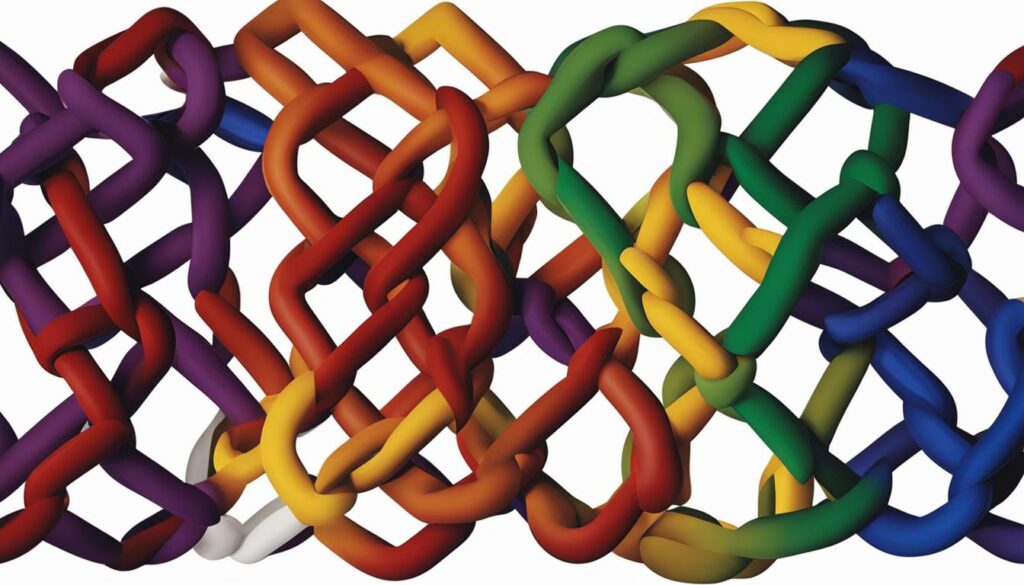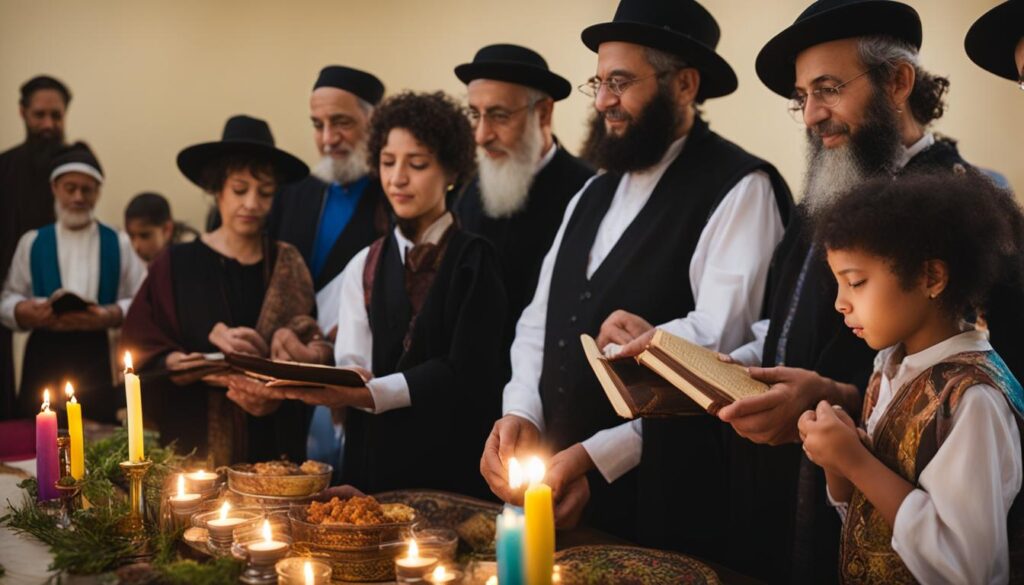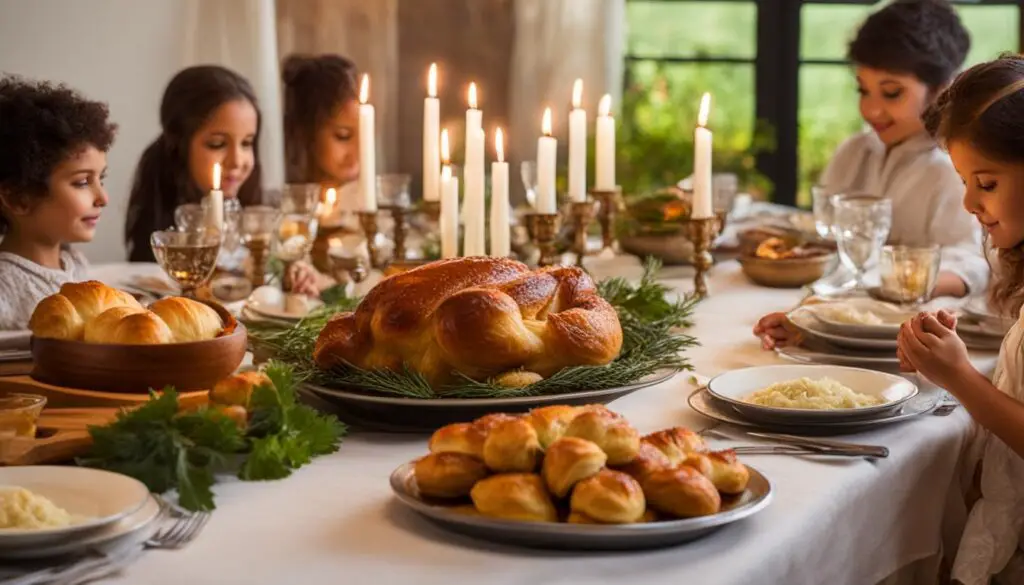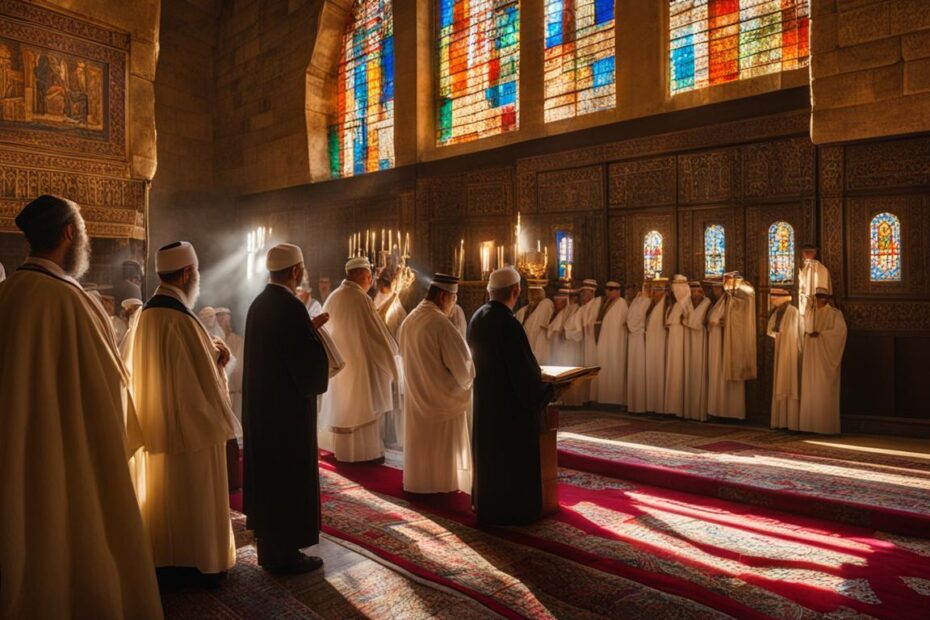Jewish prayer traditions are deeply rooted in the customs and practices of the Jewish faith. It is an essential part of connecting with Jewish identity and spirituality. The act of praying allows individuals to communicate with God, expressing gratitude, seeking guidance, and finding solace in times of joy and sorrow.
In Judaism, the obligation to pray three times a day was established in honor of the three patriarchs – Abraham, Isaac, and Jacob. Each of them had their own significant prayer moment. The timing and duration of prayers vary throughout the day, with specific periods designated for morning, afternoon, and evening prayers.
Prayer rituals in Judaism follow a structured framework that encompasses various components, including reciting specific prayers, bowing, and covering one’s eyes with the Tallit (prayer shawl). These practices promote focus, reverence, and a sense of connection to a higher power.
Key Takeaways:
- Jewish prayer traditions are deeply rooted in the customs and practices of the Jewish faith.
- Prayers in Judaism are an essential way to connect with Jewish identity and spirituality.
- The obligation to pray three times a day honors the three patriarchs, Abraham, Isaac, and Jacob.
- Jewish prayer rituals follow a structured framework that includes reciting specific prayers and engaging in physical gestures.
- Praying allows individuals to communicate with God, express gratitude, seek guidance, and find solace.
The Talmudic System of Prayer Periods
In Jewish prayer traditions, the talmudic system plays a crucial role in determining the timing of prayer periods throughout the day. This system divides the period between dawn and dusk into twelve seasonal “hours,” with each hour’s length varying based on the time between sunrise and sunset.
Here is a breakdown of the prayer periods based on the talmudic system:
| Prayer | Time Period |
|---|---|
| Morning Shema | From sunrise until the end of the third hour |
| Morning Amidah | Until the end of the fourth hour |
| Afternoon Amidah | From the first half of the seventh hour until sundown |
| Evening Amidah | Throughout the night starting from sundown |
It’s important to note that in certain circumstances, the timing of prayers can be adjusted to accommodate the availability of a minyan or to fulfill the minimal standards for daily prayer.
The talmudic system of prayer periods provides structure and guidance for devout Jews in their daily worship, allowing them to connect with the Divine and find solace in their faith.

Relevant Thoughts:
The talmudic system of prayer periods offers a framework for Jews to align their spiritual practice with the rhythm of the day. It allows individuals to be mindful of the sacred moments within each hour, fostering a deeper connection with the Divine.
Personal Engagement with Jewish Prayer
While Jewish Americans may not be highly religious in terms of traditional measures of observance, many still engage with Jewish prayer in various ways. Cooking or eating traditional Jewish foods and sharing Jewish culture and holidays with non-Jewish friends are common forms of engagement. Additionally, observing life milestones such as bar or bat mitzvahs and participating in Passover Seders are significant prayer-related activities. However, only a small percentage of Jews attend religious services regularly, with many expressing their Jewishness in alternative ways.

Despite the limited attendance at religious services, personal engagement with Jewish prayer showcases the enduring significance of prayer in Judaism. It allows individuals to connect with their heritage, express their cultural identity, and find meaning and spirituality in their daily lives. Whether through culinary traditions, interfaith interactions, or participation in important cultural rituals, Jewish prayer remains an essential aspect of Jewish life and identity.
Examples of Personal Engagement with Jewish Prayer
Personal engagement with Jewish prayer can take many forms, each contributing to the preservation of Jewish traditions and the celebration of Jewish values. Here are a few examples:
- Cooking or eating traditional Jewish foods: By preparing and enjoying meals that are part of Jewish culinary traditions, individuals can connect with their heritage and strengthen their sense of identity.
- Sharing Jewish culture and holidays: Inviting non-Jewish friends to celebrate Jewish holidays or sharing aspects of Jewish culture such as music, literature, or art fosters interfaith understanding and allows for meaningful conversations about faith and tradition.
- Observing life milestones: Bar or bat mitzvah ceremonies mark a significant stage in a young person’s life, symbolizing their religious and communal responsibilities. This milestone encourages engagement with prayer and Jewish teachings.
- Participating in Passover Seders: Passover, one of the most important Jewish holidays, is filled with rich traditions and prayers. Joining in the Passover Seder, a special meal and ceremony, allows individuals to actively engage with Jewish prayer and reconnect with their roots.
These examples illustrate how personal engagement with Jewish prayer extends beyond formal religious services. They demonstrate the adaptability and versatility of Jewish prayer, making it accessible to individuals from various backgrounds and levels of religious observance.
| Forms of Personal Engagement with Jewish Prayer | Percentage of Jewish Americans Engaging |
|---|---|
| Eating traditional Jewish foods | 67% |
| Sharing Jewish culture and holidays | 54% |
| Observing life milestones (bar/bat mitzvahs) | 39% |
| Participating in Passover Seders | 33% |
The table above showcases the prevalence of different forms of personal engagement with Jewish prayer among Jewish Americans. It is apparent that these activities play a significant role in keeping Jewish traditions alive and thriving within the community.
Connecting with Judaism Through Cultural Practices
Many Jews find meaningful connections to Judaism through engaging in cultural practices that celebrate Jewish identity. These practices serve as a way to preserve traditions, promote a sense of belonging, and strengthen Jewish community ties. Cultural connections encompass various aspects, including cuisine, sharing Jewish culture and holidays, visiting historical sites, and engaging with Jewish media.
Cuisine: A Taste of Jewish Heritage
Jewish cuisine holds a special place in Jewish culture, with traditional recipes passed down through generations. From matzo ball soup to challah bread, Jewish food is not only a source of nourishment but also a reflection of Jewish history and heritage. Many Jews enjoy cooking or eating Jewish foods as a way to honor their ancestors, connect with their roots, and build bridges with other cultures.
| Jewish Foods | Description |
|---|---|
| Matzo Ball Soup | A traditional soup made with matzo meal dumplings, often served during Passover. |
| Challah Bread | A braided bread typically eaten on Shabbat and other Jewish holidays. |
| Latkes | Potato pancakes traditionally eaten during Hanukkah. |
Sharing Jewish Culture and Holidays
Sharing Jewish culture and holidays with non-Jewish friends provides an opportunity to showcase Jewish traditions, beliefs, and values. It fosters cross-cultural understanding, strengthens interpersonal relationships, and promotes unity. Many Jews invite friends and colleagues to celebrate Jewish holidays such as Hanukkah, Passover, and Purim, allowing others to experience Jewish customs and rituals firsthand.
In sharing Jewish culture with the wider community, we celebrate our heritage and contribute to a more inclusive society.
– Rabbi David, Temple Beth El
Visiting Historical Jewish Sites
Visiting historical Jewish sites, both within the United States and abroad, allows individuals to connect with Jewish history, identities, and narratives. Experiencing firsthand the locations where significant events took place, such as the Western Wall in Jerusalem or the Lower East Side Tenement Museum in New York City, can deepen one’s understanding of Jewish heritage and foster a sense of belonging to a broader Jewish community.
Engaging with Jewish Media
Jewish literature, history, biographies, and media offer opportunities for intellectual and emotional engagement with Jewish identity and culture. Reading books by Jewish authors, exploring Jewish historical accounts, or watching films with Jewish or Israeli themes provide avenues for cultural connection. Jewish media not only educates and entertains but also helps individuals form a deeper understanding of their own Jewish identity and heritage.

Engaging with Jewish culture through food, sharing traditions and holidays, visiting historical sites, and consuming Jewish media allows individuals to forge a strong connection to their Jewish identity and heritage. These practices differ in popularity among age groups and denominations, with Orthodox Jews often engaging more in traditional Jewish practices. Nevertheless, they provide avenues for all Jews to embrace and celebrate their culture, contributing to a vibrant and inclusive Jewish community.
The Significance of Shabbat
Shabbat, the Jewish day of rest, holds great importance for many Jews. It is a time to pause, reflect, and rejuvenate, creating a sacred space for spiritual connection and community. The observance of Shabbat is rooted in ancient traditions and serves as a weekly reminder of the values and principles cherished by the Jewish people.
Shabbat Traditions
Shabbat is marked in a personally meaningful way, with individuals and families embracing a variety of traditions that have been passed down through generations. These traditions include:
- Resting: Shabbat allows Jews to engage in physical and mental rest, setting aside the demands of daily life and focusing on self-care and spirituality.
- Attending Religious Services: Many Jews gather in synagogues or prayer communities to participate in Shabbat services, where they engage in communal prayer, song, and Torah study.
- Lighting Candles: The lighting of Shabbat candles signifies the beginning of this sacred day and brings warmth and light into the home. It is often accompanied by special blessings.
- Gathering with Friends and Family: Shabbat provides an opportunity for loved ones to come together, share a festive meal, and enjoy quality time in each other’s company.
- Engaging in Community Service: Many Jews view Shabbat as a time to give back to their community, volunteering their time and resources to help those in need.
“Shabbat is a time for introspection, joy, and gratitude. It allows us to reconnect with our spiritual roots and find solace in the embrace of our community.”
Importance of Shabbat
Shabbat holds a deep significance in Jewish life, serving as a foundation for faith, identity, and a sense of belonging. It provides an opportunity for individuals to connect with their heritage, values, and the rhythm of the Jewish calendar. The observance of Shabbat allows Jews to:
- Recharge and Reflect: Shabbat offers a designated time to step away from the busyness of everyday life and reflect on one’s actions, values, and purpose. It provides a space for inner introspection and spiritual growth.
- Cultivate Community: Observing Shabbat together with family and friends fosters a sense of belonging and strengthens interpersonal relationships. It creates an environment where individuals can share experiences, create lasting memories, and find support and connection within their community.
- Nurture Faith: Shabbat rituals and traditions bring Jewish values and teachings to life. By engaging in prayer, study, and joyful celebrations, individuals reaffirm their faith and commitment to their religious beliefs.
- Find Meaning and Purpose: Shabbat provides an opportunity to step back from the materialistic world and focus on what truly matters. It invites individuals to find meaning, purpose, and fulfillment beyond the pursuit of material possessions.
While the frequency and extent of Shabbat observance vary among individuals, studies have shown that Jews by religion and in-married Jews are more likely to engage in meaningful Shabbat practices. They recognize the immense value of this sacred time and the profound impact it can have on their spiritual, emotional, and communal well-being.

Shabbat traditions and the importance of Shabbat are deeply woven into the fabric of Jewish life, providing a meaningful framework for spiritual connection, reflection, and community engagement. By embracing the richness of Shabbat observance, individuals can deepen their connection to their Jewish heritage, find solace in sacred traditions, and strengthen their bond with the wider Jewish community.
Engaging with Jewish Culture through Food and Media
Jewish culture is a vibrant tapestry woven with delicious flavors and captivating stories. Through the exploration of Jewish cuisine and media, individuals can forge deeper connections to their heritage and strengthen their Jewish identity.
Delightful Jewish Cuisine
Food has always played a central role in Jewish culture, fostering traditions and nurturing bonds. Many Jews regularly engage with their heritage by cooking or enjoying Jewish foods. From savory matzo ball soup to mouthwatering challah bread, each dish carries the essence of Jewish culture.
Sharing Jewish cuisine and holidays with non-Jewish friends also serves as a powerful way to celebrate Jewish identity and foster understanding. Breaking bread together allows diverse communities to forge connections through the shared experience of delightful flavors and cultural exchange.
Jewish Media: A Cultural Gateway
Exploring Jewish media offers a window into the rich tapestry of Jewish life and history. Whether through literature, news, music, or films, individuals can immerse themselves in stories that resonate with their Jewish heritage and values.
Visiting historical Jewish sites during travels further deepens the connection to Jewish culture and fosters an appreciation for the rich legacy of the Jewish people.
“Jewish cuisine and media offer gateways to our cultural heritage, allowing individuals to connect with their Jewish identity and share the richness of our traditions with others.”
– Rabbi David Cohen
Engagement Across Generations and Denominations
While engagement with Jewish media may vary across age groups and denominations, it remains a powerful tool for cultural connection and identity formation. Younger generations often explore Jewish culture through a digital lens, engaging with Jewish podcasts, blogs, and online communities.
Orthodox Jews, with their emphasis on traditional practices and limited exposure to secular media, may place less emphasis on television and films. Instead, they often engage more deeply with traditional Jewish texts and religious teachings.
Regardless of age or denomination, Jewish cuisine and media offer opportunities for meaningful engagement with Jewish culture, fostering a sense of pride, belonging, and connection to a vibrant heritage.

| Engagement with Jewish Cuisine | Engagement with Jewish Media | |
|---|---|---|
| Benefits |
|
|
| Engagement |
|
|
| Variations |
|
|
Political Activism and Jewish Identity
Political activism serves as a powerful means for Jews to express their Jewish identity and values. It transcends political affiliations, with both Jewish Republicans and Democrats actively participating in political movements and causes.
Conservative Jews, in particular, are more inclined to engage in political activism as an expression of their Jewishness and commitment to their community.
“Political activism allows us to channel our passion for justice and equality into meaningful action. As Jews, we have a longstanding tradition of advocating for social justice, rooted in our sacred texts and history. By engaging in political activism, we can work towards creating a better world that aligns with our values and ensures the well-being of all individuals.”
Campaigning for causes such as civil rights, immigration reform, environmental protection, and combating anti-Semitism, Jewish activists play a vital role in shaping public opinion and influencing policy decisions. Political engagement not only amplifies Jewish voices but also fosters unity and solidarity within the Jewish community.
“Political activism empowers us to be agents of change and to uphold the principles of tikkun olam, repairing the world. It is an integral part of asserting our Jewish identity and making a positive impact on society as a whole.”
| Political Affiliation | Percentage of Jewish Activists |
|---|---|
| Republican | 42% |
| Democrat | 56% |
| Other | 2% |
Source: Jewish Study
Engaging in Political Activism: A Commitment to Jewish Values
When Jews actively participate in political activism, they embody the core principles of their faith. The pursuit of social justice, equality, compassion, and the fight against discrimination are deeply rooted in Jewish teachings and traditions. By combining their political beliefs with their Jewish identity, Jewish activists become a force for positive change in the world.
Moreover, political activism enhances Jewish pride and strengthens the bond within the community, fostering a sense of unity and solidarity. It provides a platform for Jews to come together, collaborate, and work towards a more inclusive and equitable society.
Through their political engagement, Jews demonstrate that their commitment to Jewish values extends beyond the confines of religious observance, profoundly impacting the social, political, and cultural landscapes. Their activism serves as a shining example of how Jewish identity can inspire and mobilize individuals to make a difference in the world.
Keeping Kosher and Owning Jewish Items
Keeping kosher is a cherished practice within Judaism, upheld by a minority of U.S. Jews. Orthodox Jews demonstrate the highest adherence to kosher dietary laws, while a small percentage of Conservative and Reform Jews maintain kosher practices in their homes. Jews who do not affiliate with a specific denomination generally do not observe kosher dietary laws.
In addition to observing kosher, many Jews also express their connection to Jewish traditions and rituals through ownership of significant Jewish items. These items serve as symbols of faith and identity, carrying deep cultural and religious significance.
Some common Jewish items owned by Jews include:
- Menorahs
- Mezuzahs
- Siddurim (prayer books)
- Seder plates
These cherished items not only serve as spiritual reminders within Jewish households but also facilitate the observance of religious rituals and traditions.
| Marital Status | Ownership of Jewish Items |
|---|---|
| Married | Higher likelihood of owning Jewish items |
| Single | Varying prevalence of owning Jewish items |
The ownership of Jewish items also varies based on denominational affiliation, with Orthodox Jews valuing these items more prominently in their religious practices.
Quote:
“Ownership of Jewish items provides us with a tangible connection to our heritage and allows us to infuse our daily lives with Jewish spirituality and customs.” – Rabbi David Cohen
By incorporating kosher practices and owning Jewish items, individuals can enrich their Jewish identity and maintain a strong connection to Jewish traditions and rituals.
Participation with Chabad
Chabad, an Orthodox Jewish movement and organization, offers engaging activities and services that attract a small percentage of U.S. Jewish adults. Known for their inclusive outreach efforts, Chabad welcomes Jews from different denominations and those with no particular branch affiliation, providing opportunities for engagement to less observant Jews. These activities and services promote a sense of community and offer avenues for individuals to explore and strengthen their Jewish identity.
Chabad Activities and Programs
Chabad offers a wide range of activities and programs that cater to the diverse interests and needs of its participants. From educational seminars and workshops to holiday celebrations and cultural events, Chabad provides a platform for individuals to connect with their Jewish heritage and traditions. Some of the common activities and programs organized by Chabad include:
- Torah classes and study groups
- Shabbat and holiday services
- Community service projects
- Youth programs and camps
- Family-oriented events
- Support groups and counseling services
Through these activities, Chabad creates a warm and welcoming environment where participants can explore and develop their spiritual connection, engage in meaningful conversations, and build relationships with others who share similar values and beliefs. These activities also provide avenues for individuals to deepen their understanding of Jewish teachings and practices.
Chabad’s Impact on Participants
Engaging with Chabad can have a profound impact on participants, nurturing their sense of Jewish identity and fostering a greater appreciation for Jewish values and traditions. Many individuals who participate in Chabad activities and services report feeling a sense of belonging, finding a supportive community where they can express and explore their Jewishness.
“Chabad has been a transformative experience for me. Through their programs, I have not only discovered the richness and depth of Jewish teachings but have also found a community that embraces and accepts me for who I am. I am grateful for the opportunities Chabad has provided me to connect with my Jewish identity.”
The Reach of Chabad’s Outreach
| Participant Demographics | Percentage |
|---|---|
| Identify as Jewish by religion | 85% |
| Have Jewish spouses | 70% |
| No particular branch affiliation | 40% |
| Less observant Jews | 30% |
Chabad’s outreach efforts extend to Jews from diverse backgrounds, fostering a sense of unity and inclusivity within the Jewish community. By embracing participants from different denominations and reaching out to those with less religious observance, Chabad plays a vital role in connecting individuals to their Jewish roots and building bridges between various segments of the community.
Participating in Chabad activities and services offers individuals the opportunity to deepen their connection to Judaism, strengthen their sense of community, and embark on a journey of spiritual growth and self-discovery. Whether attending Torah classes, joining in holiday celebrations, or engaging in community service, Chabad provides a supportive and welcoming environment for individuals to explore and embrace their Jewish identity.
Conclusion
Jewish prayer customs and practices are diverse and deeply rooted in the beliefs and traditions of Jewish communities and denominations. While prayer times and specific rituals may vary, the significance of prayer in Judaism remains a central pillar of worship. Engaging with prayer through personal and communal practices, cultural connections, and the observance of Shabbat plays a vital role in strengthening individuals’ connection to their Jewish identity and community.
Through the centuries, Jewish prayer has offered a profound means of communication with the divine. It has served as a source of solace, guidance, and gratitude, fostering a sense of spiritual connection and unity among Jewish individuals. From morning prayers to evening prayers, from reciting the Shema to offering Amidah, each prayer practice carries deep meaning and reflects the core values and beliefs of the Jewish faith.
Furthermore, Jewish prayer customs extend beyond religious observance alone. They encompass various cultural practices, including culinary traditions, engaging with Jewish literature, music, and films, visiting historical sites, and participating in meaningful acts of community service. These practices provide additional avenues for individuals to connect with their Jewish heritage and forge a stronger sense of belonging and purpose.
In conclusion, Jewish prayer customs and practices offer a multifaceted and transformative experience that encompasses personal and communal devotion. Through prayer, individuals can deepen their connection to Jewish traditions, strengthen their spiritual bond, and find solace, inspiration, and fulfillment in their faith.
FAQ
What are Jewish prayer traditions?
Jewish prayer traditions are deeply rooted in the customs and practices of the Jewish faith. They encompass various rituals and prayers that are performed at specific times throughout the day and on special occasions.
How many times a day do Jews pray?
Jews are obligated to pray three times a day – in the morning, afternoon, and evening. These prayer times are established in honor of the three patriarchs of Judaism – Abraham, Isaac, and Jacob.
How does the timing of prayers work?
The timing of prayers in Judaism is based on the talmudic system, which divides the period between dawn and dusk into twelve “hours”. The length of each hour changes based on the time between sunrise and sunset.
What are some ways individuals engage with Jewish prayer?
Many Jews engage with prayer by participating in religious services, observing life milestones like bar or bat mitzvahs, and attending Passover Seders. Cooking or eating traditional Jewish foods and sharing Jewish culture with non-Jewish friends are also common forms of engagement.
How can one connect with Judaism through cultural practices?
Cultural practices such as cooking or eating Jewish foods, sharing Jewish holidays with non-Jewish friends, visiting historical Jewish sites, and consuming Jewish media provide avenues for connecting with Jewish identity and culture.
What is the significance of Shabbat in Judaism?
Shabbat, the Jewish day of rest, holds great importance. Observing Shabbat can involve traditional practices like resting and attending religious services, as well as personal activities like gathering with friends and engaging in community service.
How is Jewish culture experienced through food and media?
Many Jews regularly cook or eat Jewish foods as a way to connect with their heritage. Sharing Jewish culture and holidays with non-Jewish friends and engaging with Jewish literature, news, music, and films also contribute to cultural connection.
Do Jews engage in political activism?
Yes, many Jews express their Jewish identity through political activism, regardless of their political affiliations. Conservative Jews, in particular, are more likely to engage in political activism as an expression of their Jewishness.
How common is keeping kosher and owning Jewish items?
Keeping kosher, the dietary practice followed by Orthodox Jews, is less common among other denominations. Ownership of Jewish items like mezuzahs, menorahs, and prayer books varies based on marital status and denominational affiliation.
What is Chabad’s role in Jewish participation?
Chabad, an Orthodox Jewish movement and organization, attracts a small percentage of Jewish adults for participation in activities and services. Chabad reaches out to Jews of different denominations and those without affiliation, offering opportunities for engagement.
Why is prayer important in Judaism?
Prayer holds a central role in Jewish worship and is considered an important aspect of Jewish life. Engaging with prayer through personal and communal practices helps to strengthen individuals’ connection to their Jewish identity and community.









